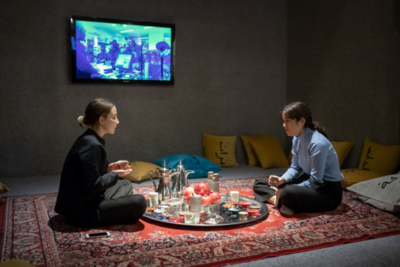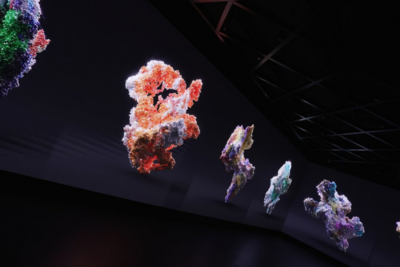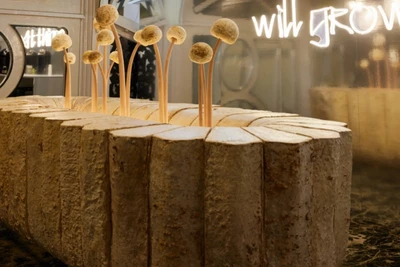
Please install a more recent version of your browser.
19 December 2022
5 minutes read
How can you stay relevant in a turbulent world full of transformations as a designer? How can or should you take into account all social changes in politics, economy, health,...? At our ‘Expert Day Design: Futureproof Entrepreneurship' strategist, trend analyst and innovation coach Kate Stockman shared ten tips for the future to deal with these challenges as a designer.
Kate Stockman is a successful and experienced brand and business strategist, future researcher and innovation coach. She leads strategy workshops and creative ‘ideation’ sessions and helps both brands and companies — such as Tomorrowland, The Woody Group, Deknudt Mirrors, Wright, Bpost en Coca-Cola — to see their blind spots and bet on sustainable, realistic growth.
"My tips are made for people who really want to move forward, for designers who want to be part of the solution, not of the problem. I want to give them tools and examples of hopeful initiatives that inspire."
In this polarising world, we often tend to focus on the differences between people. Yet we increasingly see hopeful initiatives that show that it can be done differently. In these initiatives, the focus is on what we have in common as human beings. 'De Huiskamer' (‘The Living Room’) at the Van Abbemuseum in the Netherlands is an example of such a hopeful initiative. In the museum's entrance hall, visitors can interact with new residents who have ended up in Eindhoven via refugee routes or other ways. You can interact with these people and get to know each other's culture. If you want to remain relevant as a designer in the future, you will have to bring people together and look for what makes us human and what we share. In doing so, designers can help to restore communities.

De Huiskamer, Archives Van Abbemuseum, Eindhoven, the Netherlands. Photo: Marcel de Buck, Eindhoven, the Netherlands
A trend that has been around for a while is the call for transparency. Companies need to inform their consumers about the origin and production process of their products. Kate Stockman sees an accelerated form of initiatives today where we are moving towards radical transparency. This is mainly about consumer awareness. The need to effectively want to know how a product was made, is growing. For example, there are pop-up initiatives in the Netherlands that have started working on radical transparency. They calculate the additional price of a product by including not only its carbon footprint but also the environmental damage and waste produced. The demand for this radical form of transparency comes from consumers themselves. Designers will have to adapt to this.
When we communicate about launches or ideas, for example, we assume that our message will automatically reach the audience. Kate Stockman stresses that we live in a world where everything has to be shareable, but also very visual. Long texts are complex and miss the mark. As a designer, you should develop your own strong 'visual language' that attracts attention and will be shared, which will increase your reach.
In today's society, we face an enormous amount of noise and stimuli on a daily basis. Yet Kate Stockman observes that a countermovement is underway. Increasingly, people are referring to the essentials, creating a kind of peacefulness. Noise, visual and intellectual stimuli are being removed so that things become more pleasant for consumers. For example, supermarket Consum in Spain recently removed all non-essential images, signage and branding so that their customers can shop with a calm mind. When people have too much choice, they buy less, but we also really need it. As a designer, it becomes important to emphasise the essentials.
Robots, the metaverse and humanoids. For a lot of people, these things seem like something far away. Yet today we are already surrounded by robots and A.I. and some people are living in the metaverse. Kate Stockman advises to accept this and to look at the exciting side of these developments. Together, we should make the metaverse a 'betterverse', a parallel digital world that is better than the one we live in now. Designers who embrace robots, the metaverse and humanoids and do not see technology as a problem will discover a totally new world of possibilities.
Anything to do with craft and manual work is becoming more important. Think of fabrics, materials, workmanship, handmade products, or anything that has a story attached to it and where human hands have worked on. Meneertje Teelepel in Melle, for example, is betting on this. The designer offers hand-carved, artisanal wooden spoons. There are also a number of artisanal culinary knife makers who bring beautiful quality products. As humans, we value it more and more. People's roots and culture are also being highlighted by designers today, creating emotionally unique objects. Kate Stockman noticed this during the Dutch Design Week in October. As a designer, you can think about this and work with it.

Hand-carved spoons, Meneertje Teelepel
More and more projects that emphasise fantasy and poetry are emerging. These initiatives aim to counterbalance the harsh and insecure world we live in. Major fashion brands respond to this by creating 'magical' shop windows or installations in which we can lose ourselves. For example, every year at the Milan Design Week, there is a poetic installation by COS developed with an architect or artist. International fashion brand Jacquemus also embraced this trend by organising fashion shows in lavender or cornfields in southern France. A wonderful way to escape the mainly negative news we hear every day. As a designer, you can also try to create such a magical, poetic world.
Today, we mainly focus on the visual aspect of things but we often forget to include the tactile and auditory as well. People should be able to look, feel and listen. For example, IKEA has turned its classical picture catalogue into a really fun audiobook. Or at the cocktail bar and restaurant City Social in London, you get VR glasses with your cocktail that allows you to see a world tailored to the cocktail you are currently drinking. It is up to designers to start working with more tactile and auditory elements as well.
Making the intangible tangible is something Kate Stockman sees coming back more often, also at the Dutch Design Week. Designers are making things you can't grasp, such as feelings, tangible and personalised. A more extreme example is converting sound into a real object. Using the system Voice Gems, the voice of beatboxer, creative technologist and voice experimentalist Harry Yeff is converted via computers into crystals, which are 3D printed. In this way, sound becomes tangible. As a designer, it can be interesting to experiment with this.

Voice Gems, Harry Yeff (Reeps100) © Trung Bao
Human intelligence and artificial intelligence, we all know it. But today, more importance is being attached to natural intelligence, the intelligence of nature. Nature, which has been around for millions of years, has developed its own mechanics. As designers, it is interesting to see how nature solves things and how we can adopt these techniques. For instance, there is the Wood Wide Web, a network of fungal threads that can stretch for many kilometres. Scientific research shows that plants and trees can communicate with each other via these fungal threads. Among other things, they can warn each other for danger via these fungal threads. Inspired by this, the design agency WeWantMore recently built a real bar 'The Mush Room' from ever growing fungi, a living object as it were. Equating natural intelligence with human intelligence and artificial intelligence makes sense.

The Mush Room, WeWantMore © HIX
Cookies saved